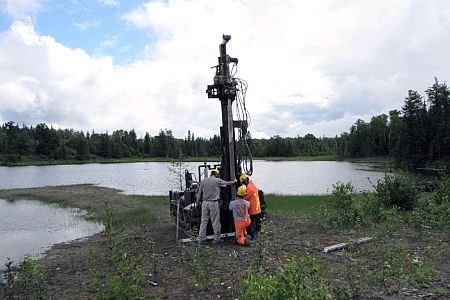Less than two years into its plan to look at recovering silver from the ample mine tailings in the Cobalt camp, BacTech Mining Corporation is reaching out to potential partners, and restructuring the company to better fund its efforts.
BacTech, whose proprietary bioleaching technology can extract metals from mine tailings while also neutralizing the arsenic within, has entered into discussions with Temex to consider processing the 1.8 million tonnes of tailings it has within the Cobalt camp.
The Temex tailings sit next to BacTech’s Castle tailings, where president Ross Orr hopes to build a $20-million test plant to determine the viability of metal recovery. The initial plant would be able to treat 200,000 tonnes per year of tailings, which, if successful, would lead to a commercial-scale plant capable of treating a million tonnes per year.
There are an estimated 18-million tons of arsenic-laden tailings in the Cobalt camp, most of which still contain cobalt, nickel, copper and residual silver.
However, Orr harbors some concerns that the grades of cobalt and nickel within the Temex tailings are “just not that high,” with silver grades hitting 1.75 to 2 ounces of silver per ton. In comparison, silver grades at the Castle tailings reach nearly 5 ounces of silver per ton.
“That’s a $100 rock versus a $40 rock, or less, so we’ll probably look for an additional site as well,” says Orr.
These and other plans, however, are being delayed somewhat as a result of plans to look at splitting the company down the middle, something Orr says is necessary to better access public and private funding opportunities.
“Everything’s deflected a bit in the short-term, because unbeknownst to us, having taken the technology into the mine tailings clean-up side, we created a lot of confusion amongst people who are shareholders and people who want to be shareholders.”
As an example, he points to clean technology fund investors, who have shown some interest in the Cobalt work. However they are unable to invest in BacTech due to their association with primary mining projects through their use of bioleaching in active gold and base metal projects.
“The problem is if someone says ‘Here’s $100, but I don’t want any of that money going toward mining,’ you can’t do that,” says Orr, who still awaits word from the federal government for funding from Sustainable Development Technology Canada.
“With this break, the two companies will be totally separate, and that’s at the request of a bunch of people who said ‘I like your technology, but we have no interest in mining whatsoever and we’re not allowed to invest in mining.’”
Under the proposed split, the aspect of the company catering directly to bioleaching for gold and base metals in primary mining projects would become its own entity, and would take on the existing mining properties, such as earn-in rights for an Armenian gold mining project.
It would “start with a clean slate,” including a new president, who has yet to be announced, though Orr says the individual is a former production expert with Barrick Gold.
The aspect of the company catering to the remediation of previous mine tailings will remain under the BacTech name, with Ross Orr continuing on at the helm. Orr will also serve on the board of directors at the new company to provide continuity and guidance.
All current BacTech shareholders will receive one common share of the new company for every three common shares they hold in the existing company. The company’s proprietary bioleaching technology will then be licensed from the new gold company to the reclamation-focused company.
Orr says he expects the process will take three to four months, likely wrapping up in April. Financing is being lined up for the new company, while work on BacTech’s Cobalt project has also been delayed.
Efforts at Cobalt have halted through the winter months, though environmental work will resume in the spring, with engineering work likely to be complete by the end of the coming summer.
A public forum was held in the municipality in November, attended by 60 local residents whose reaction was largely positive.
The test plant may yet be built in 2011, one year behind schedule, with some hope that money to fund the project may emerge by then, says Orr.
“It is what it is, and when you’re a small company like ours, it’s not like you have a bottomless pit (of funding.)”
www.bactech.com
www.temexcorp.com




